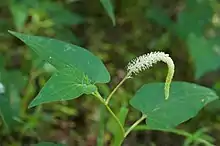Saururus cernuus
Saururus cernuus (lizard's tail, water-dragon, dragon's tail, swamp root) is a medicinal and ornamental plant native to eastern North America. It grows in wet areas or shallow water, and can be up to about a meter tall.[1] The native range covers much of the eastern United States, as far west as eastern Texas and Kansas, south to Florida, and north to Michigan and New York state, slightly into Ontario.[1] It is an obligate wetland plant, able to grow in inundated, saturated soils.[2]
| Lizard's tail | |
|---|---|
 | |
| S. cernuus, foliage and inflorescence | |
| Scientific classification | |
| Kingdom: | Plantae |
| Clade: | Tracheophytes |
| Clade: | Angiosperms |
| Clade: | Magnoliids |
| Order: | Piperales |
| Family: | Saururaceae |
| Genus: | Saururus |
| Species: | S. cernuus |
| Binomial name | |
| Saururus cernuus | |
Saururus cernuus is a herbaceous perennial that gets its name from the white flowers that bloom in the summer months.[2] Flowers usually grow to be 6 to 8 inches long.[3] After the flowers reach maturity the white flowers turn brown, giving the plant its namesake, lizard's tail.[3] The leaves are usually heart-shaped, arrow-shaped, or lance-shaped, and are arranged alternately on the stem.[3] When the leaves are crushed they release a citrus or sassafras aroma.[3][2]
As an aquatic plant, S. cernuus is an important food source for many wetland animals, including beavers.[4] In an exclusion study beavers reduced the prevalence of S. cernuus by 45%.[4]
Its medicinal properties have been used to treat swelling in the body.[2] Cherokee and Chocktaw native Americans mashed up S. cernuus roots as a poultice, and applied the plant to soothe inflammation of the breasts and back.[5][6] The Seminoles used the plant as an antirheumatic, as well as a way to soothe fevers and body aches.[7]
References
- "Saururus cernuus". Flora of North America.
- "Lady Bird Johnson Wildflower Center - The University of Texas at Austin". www.wildflower.org. Retrieved 2019-11-14.
- "Saururus cernuus – UF/IFAS Center for Aquatic and Invasive Plants". plants.ifas.ufl.edu. Retrieved 2019-11-14.
- Parker, John D.; Caudill, Christopher C.; Hay, Mark E. (2006-12-16). "Beaver herbivory on aquatic plants". Oecologia. 151 (4): 616–625. doi:10.1007/s00442-006-0618-6. ISSN 0029-8549. PMID 17180372. S2CID 16924452.
- Bushnell, David I., Jr. (David Ives), 1875-1941. (1909). The Choctaw of Bayou Lacomb, St. Tammany Parish, Louisiana. G.P.O. OCLC 32137526.CS1 maint: multiple names: authors list (link)
- Witthoft, John (April 1948). "Will West Long, Cherokee Informant". American Anthropologist. 50 (2): 355–359. doi:10.1525/aa.1948.50.2.02a00250. ISSN 0002-7294.
- Sturtevant, William, 1954, The Mikasuki Seminole: Medical Beliefs and Practices, Yale University, PhD Thesis, page 204